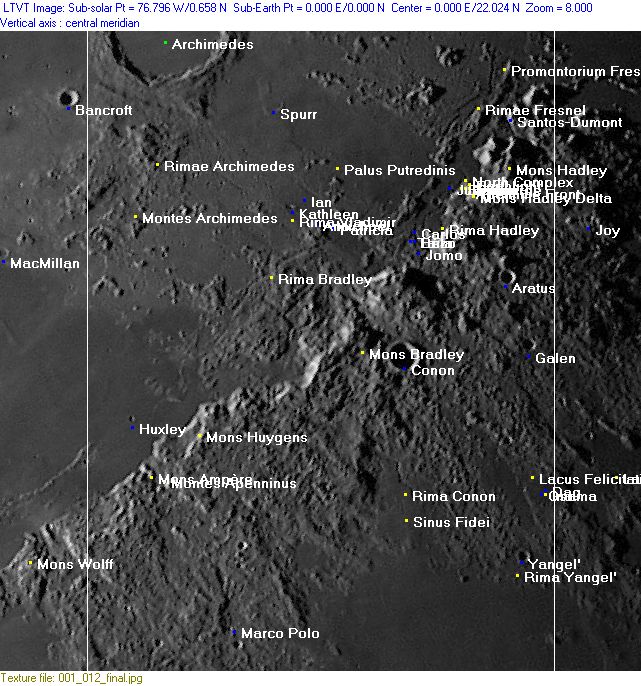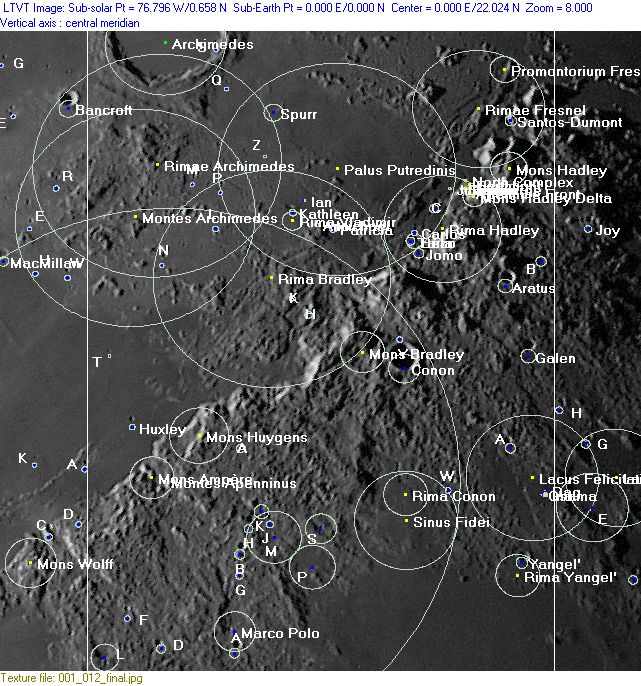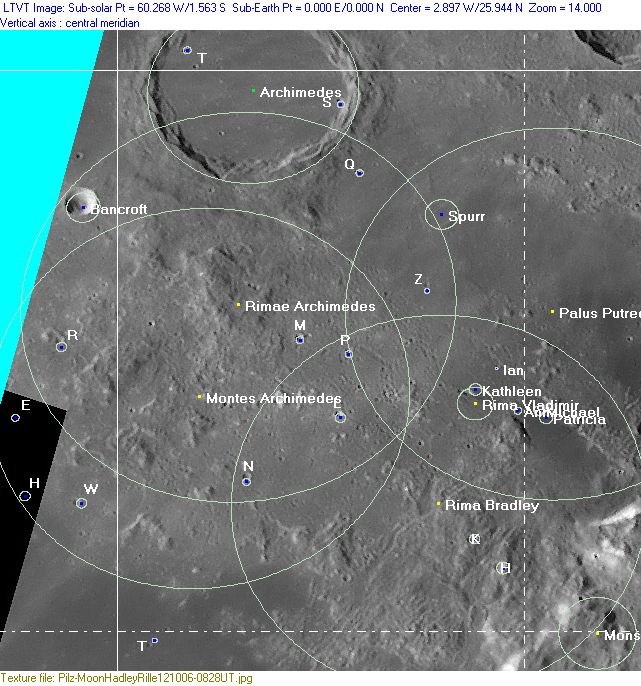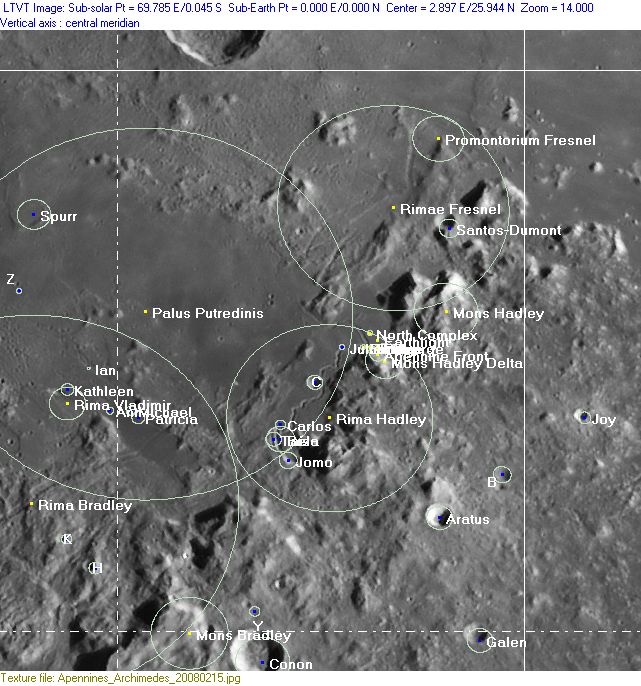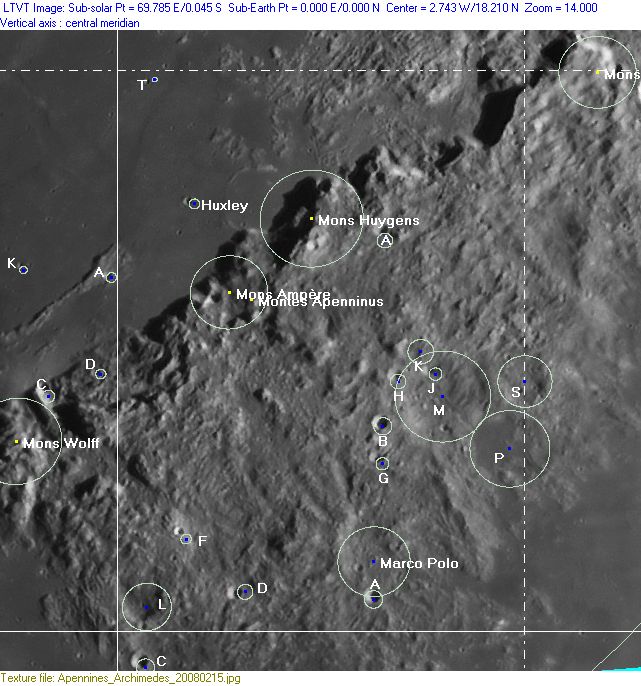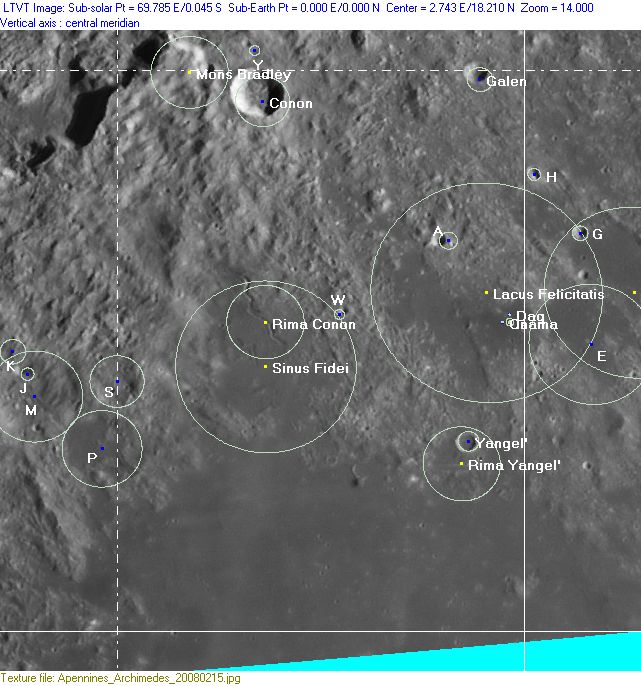Difference between revisions of "Rükl 22"
(Created page with "<div id="content_view" class="wiki" style="display: block"> =Rükl Zone 22 - CONON= <br /> Neighboring maps on the [http://the-moon.us/wiki/R%C3%BCkl%20Index%20Map Rükl Ne...") |
|||
| Line 2: | Line 2: | ||
=Rükl Zone 22 - CONON= | =Rükl Zone 22 - CONON= | ||
<br /> Neighboring maps on the [http://the-moon.us/wiki/R%C3%BCkl%20Index%20Map Rükl Nearside Map]:<br /> <div id="toc"> | <br /> Neighboring maps on the [http://the-moon.us/wiki/R%C3%BCkl%20Index%20Map Rükl Nearside Map]:<br /> <div id="toc"> | ||
| − | + | ||
| − | |||
{| class="wiki_table" | {| class="wiki_table" | ||
| | | | ||
| Line 144: | Line 143: | ||
==The Twins immediately west of Hill 305== | ==The Twins immediately west of Hill 305== | ||
| − | * The unnamed pair of bowl-shaped craterlets immediately west of NASA's '''''Hill 305''''' ( [[Fresnel%20Ridge|Fresnel Ridge]] ) is a VERY interesting pair to test your telescope's optics (note: when your observing eye is capable of recognizing the peanut-looking pair as two individual craterlets, then your telescope is O.K.!). A powerful telescope is required. See also: Apollo 15's orbital Panoramic image [http://www.lpi.usra.edu/resources/apollo/frame/?AS15-P-9804 AS15-P-9804] (right half of the photographic strip). <span class="membersnap">- | + | * The unnamed pair of bowl-shaped craterlets immediately west of NASA's '''''Hill 305''''' ( [[Fresnel%20Ridge|Fresnel Ridge]] ) is a VERY interesting pair to test your telescope's optics (note: when your observing eye is capable of recognizing the peanut-looking pair as two individual craterlets, then your telescope is O.K.!). A powerful telescope is required. See also: Apollo 15's orbital Panoramic image [http://www.lpi.usra.edu/resources/apollo/frame/?AS15-P-9804 AS15-P-9804] (right half of the photographic strip). <span class="membersnap">- DannyCaes <small>Nov 11, 2008</small></span>. |
<br /> | <br /> | ||
==Bennett Hill== | ==Bennett Hill== | ||
| Line 151: | Line 150: | ||
<br /> | <br /> | ||
---- | ---- | ||
| − | + | </div> | |
Revision as of 16:48, 15 April 2018
Contents
Rükl Zone 22 - CONON
Neighboring maps on the Rükl Nearside Map:
| 22 |
||
Photographic Map
(This map is based on an Earth-based photograph that has been computer-corrected to zero libration. The vertical white lines indicate the left and right boundaries of the Rükl rectangle)
Background image source
Named Features
- Ann (between Kathleen and Patricia, label overlapped by Rima Vladimir).
- Apennine Bench Formation (informal geologic name from R.J.Hackman).
- Apollo 15 (fourth manned landing on the moon, Apollo 15's LM Falcon soft-landed on July 30, 1971, slightly southwest of Mons Hadley).
- Apollo 15 ascent stage of LM Falcon (impacted at 26.36° North/ 0.25° East, at Palus Putredinis).
- Aratus
- Archimedes (Van Langren's Roma, J.Hewelcke's Mons Argentarius).
- Autolycus Alpha (hill south of Autolycus, for Autolycus see Rukl's chart 12).
- Autolycus Beta and Autolycus Gamma (two prominent clusters of hills, west of Promontorium Fresnel and Rimae Fresnel) (for Autolycus Alpha, Beta, and Gamma; see the charts in System of Lunar Craters, 1966).
- Béla (between Carlos and Jomo, label overlapped by Taizo).
- Bela Circularity (a nickname from D.Caes for a "circular" tendency at crater Bela in Montes Apenninus) (it looks as if it's a small section of a much larger formation).
- Bennett Hill (a strictly NASA-related name for the hill just west of Rima Hadley and Apollo 15's landingsite on The Plain) (Bennett Hill is observable through common and powerful telescopes) (see also Additional Information below).
- Bosporus, Sinus Propont. ad (J.Hewelcke's disallowed name for the northeastern "corner" of Mare Vaporum).
- Carlos
- Conon
- Dag
- Donkey/ Shrek's donkey (two nicknames from A.Bozic for Lacus Felicitatis and adjacent dark region Manilius E) (to be observed during Full Moon).
- Fossa Tetrazzini (a disallowed name for Rima Archimedes VI, see Lunar Topographic Orthophotomaps 41-A3, 41-B4).
- Fresnel Ridge, aka Hill 305 (unofficial names, the name Hill 305 is strictly NASA-related, Apollo 15's LM Falcon landed slightly southeast of it).
- Galen (F.C.Lamech's Moumouris).
- Gran Sasso (an unofficial name from D.Caes for the highest peak in the Montes Apenninus)(see also: Wikipedia page Gran Sasso).
- Hadley C
- Hellespontum, Sinus Propont. ad (J.Hewelcke's disallowed name for the western "corner" of Mare Vaporum).
- Hill 305 (see Fresnel Ridge).
- Hook and Dome (a nickname from D.Caes for the curious formation immediately west of Rima Yangel') (see also LROC post 893: Dome in Mare Vaporum).
- Huxley
- Ian
- Ina / D Caldera (the very odd D-shaped caldera at Lacus Felicitatis) (label overlapped by Dag and Osama).
- Irwin (an unofficial name from D.Caes for one of the officially unnamed craterlets near the landingsite of Apollo 15 at the Hadley plain) (James Irwin, 1930-1991, Lunar Module Pilot of Apollo 15).
- Italia (regio) (J.Hewelcke's disallowed name for the region at Palus Putredinis, and also at Aristillus and Autolycus) (see Chart 12).
- Jomo
- Julienne (between Rima Hadley and Mons Hadley, label overlapped by Apollo 15 landing site names).
- Kathleen (name not mentioned in Rukl's printed version of Chart 22, although this is not really a minor feature).
- Lacus Felicitatis
- Lacus Mozart (a disallowed name for the low-albedo "lake" immediately southeast of the small craterlets Michael and Patricia, strange to say; this name was not printed on the Lunar Topographic Orthophotomaps or the Topophotomaps).
- Marco Polo
- Mare Vaporum (occupying the lower right section of Chart 22, see Chart 33 for wiki-link).
- Mariae D. Mont. F. (Van Langren's disallowed name for Hadley) (thus mentioned in E.A.Whitaker's Mapping and Naming the Moon).
- Michael
- Mons Agnes (label overlapped by Dag and Osama).
- Mons Ampère
- Mons Bradley
- Mons Hadley
- Mons Hadley Delta (not mentioned on Chart 29 in the Times Atlas of the Moon) (which is rather strange).
- Mons Huygens
- Montes Apenninus (Van Langren's Montes Austriaci).
- Montes Archimedes (once called Montes Lomonosov, see A.V.Markov's book The Moon).
- Morotcha (one of the rare names on Rand McNally's moonmap, printed at the northern part of Mare Vaporum, could be a craterlet (?) or perhaps a hillock (?), needs investigation).
- Number One/ 1 (a nickname from D.Caes for the 1-shaped western section of Lacus Felicitatis) (to be observed during Full Moon).
- Osama
- Palus Putredinis (Van Langren's Terra Virtutis) (J.Hewelcke's Lacus Trasimenus).
- Patricia
- Pi Symbol (S.Lammel's nickname for the curious system of rilles at 18° North/ 2° East, in Sinus Fidei, south of Rima Conon).
- Promontorium Fresnel
- Rima Bradley (once known as Fossa Bradley, see Lunar Topographic Orthophotomaps 41-A3, 41-B4, 41-D2).
- Rima Conon
- Rima Hadley
- Rima Mozart (a disallowed name for the rille east of Kathleen, see Lunar Topographic Orthophotomaps 41-A3, 41-B4).
- Rima Vladimir
- Rima Yangel' (the "horizontal" rille immediately south of Yangel', once known as Fossa Yangel', see Lunar Topographic Orthophotomap 41-C4).
- Rimae Archimedes (see also Fossa Tetrazzini).
- Rimae Fresnel (once known as Fossae Fresnel, see Lunar Topographic Orthophotomap 41-B4).
- Romania (regio) (J.Hewelcke's disallowed name for the region southeast of Montes Apenninus).
- Santos-Dumont
- Shiny Mound (not really a name or nickname, this is the high-albedo "island" west of Rima Hadley, in Palus Putredinis, see LROC Article Shiny Mound).
- Sinus Fidei
- Spurr
- Taizo (between Carlos and Jomo, label overlapped by Taizo).
- Terra Nivium (Riccioli's discontinued name for the region between Montes Apenninus and Montes Haemus).
- Twins (a nickname from D.Caes for the curious couple of bowl-shaped craterlets west of NASA's Hill 305, see description below at Additional Information).
- Yangel'
Additional IAU-named features associated with the Apollo 15 Site
- Apennine Front
- Bridge
- Dune
- Earthlight
- Elbow
- Index
- Last
- North Complex
- Plain
- Rhysling
- South Cluster
- Spur
- St. George (this crater on the northern slope of Mons Hadley Delta is observable through powerful telescopes).
- Terrace
Lettered Crater Locations
(click on the thumbnails to display full-sized images; use browser BACK button to return - the dashed white lines are the midpoints of the Rükl zones)
Full zone with lettered craters:
Lettered craters by quadrants:
| North West |
North East |
| South West |
South East |
Additional Information
- Other online descriptions of features in this Rükl map section:
The Twins immediately west of Hill 305
- The unnamed pair of bowl-shaped craterlets immediately west of NASA's Hill 305 ( Fresnel Ridge ) is a VERY interesting pair to test your telescope's optics (note: when your observing eye is capable of recognizing the peanut-looking pair as two individual craterlets, then your telescope is O.K.!). A powerful telescope is required. See also: Apollo 15's orbital Panoramic image AS15-P-9804 (right half of the photographic strip). - DannyCaes Nov 11, 2008.
Bennett Hill
- According to page 84 of David M. Harland's book Exploring the Moon; the Apollo expeditions, it (Bennett Hill) had been named for Floyd Bennett, the member of the flight dynamics team who devised the steep descent which had enabled Apollo 15's LM Falcon to set down at the confined Hadley-Apennine site.
